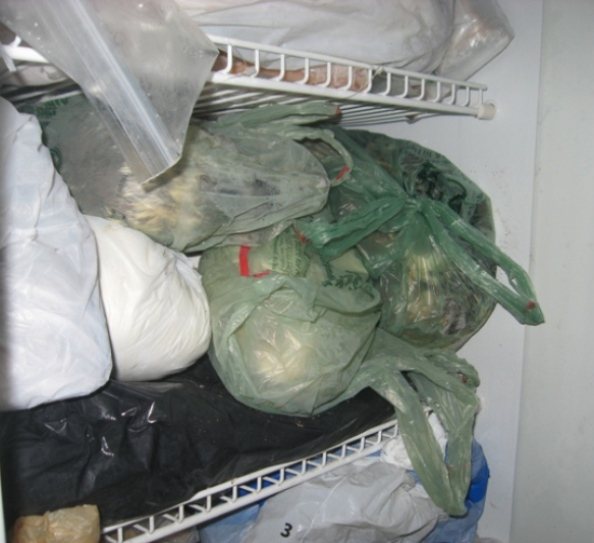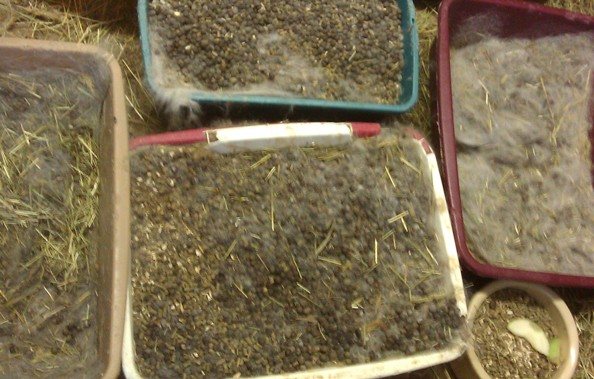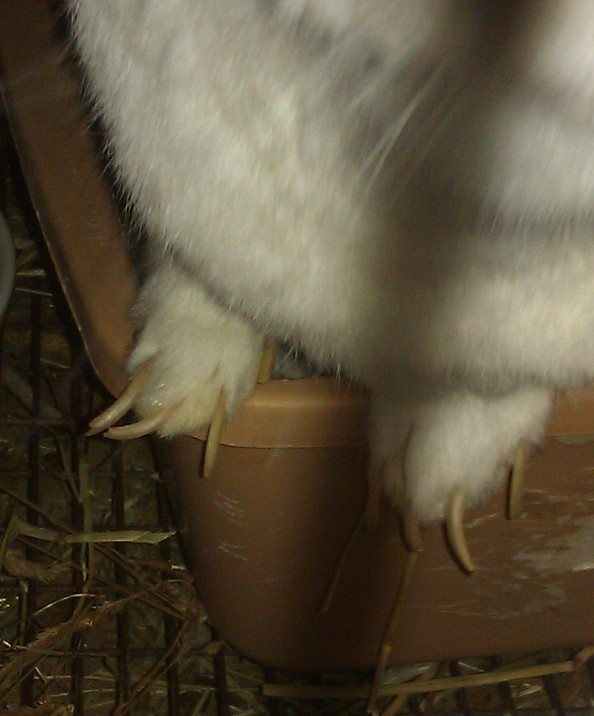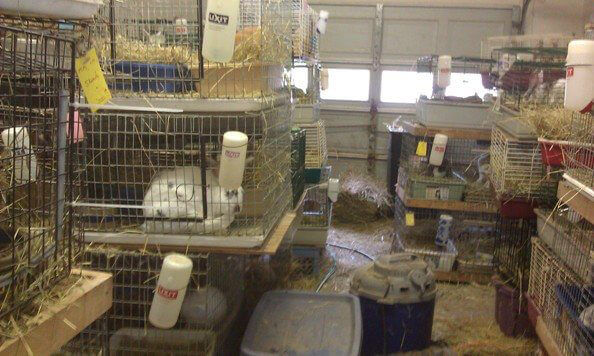GRAPHIC AND DETAILED
 UPDATE 8/15/2023: On Tuesday, August 15, 2023, Carol Badart VanWie, 77, pleaded guilty in Calvert County District Court to multiple charges involving violations of Maryland’s animal cruelty laws.
UPDATE 8/15/2023: On Tuesday, August 15, 2023, Carol Badart VanWie, 77, pleaded guilty in Calvert County District Court to multiple charges involving violations of Maryland’s animal cruelty laws.
Ms. VanWie was found to have housed more than 40 rabbits and other creatures in unsanitary and inhumane conditions at her nonprofit venture, Bunny Magic and Wildlife Rabbit Rescue, in Lusby.
VanWie was given a 90 day jail sentence with all 90 days suspended, placed on 3 years of probation, and ordered not to possess any animals. In addition, she reimbursed Calvert County the sum of $66,857.58 for the care and feeding of the animals that were confiscated from her property.
Calvert County State’s Attorney Robert Harvey wishes to commend Senior Assistant State’s Attorney Christopher J. Monte for his handling of this case. Credit also goes to Officer Allison Higgs of the Maryland Natural Resources Police who initially investigated the case and brought the charges against Ms. VanWie.
VanWie was sentenced to 90 days for the charges below by Judge Patrick R. Duley.
- Count 8 of Animal Hoarding
- Count 52 of Failure to Maintain Required Records
- Count 96 of Animal Cruelty: Failure to Provide
- Count 97 of Animal Cruelty: Failure to Provide
- Count 98 of Animal Cruelty: Failure to Provide
- Count 99 of Animal Cruelty: Failure to Provide
- Count 100 of Animal Cruelty: Failure to Provide
- Count 120 of Fail to Keep Facility Structurally Sound and in Good Repair
- Count 127 of Failure to Provide Adequate Portable Water
- Count 133 of Fail to Dispose of Animal and Food Waste
- Count 137 of Fail to Adequately Ventilate
- Count 143 of Fail to Provide Food
- Count 158 of Fail to Keep Areas Clean
4/3/2023: On January 11, 2023, Officer Higgs of the Maryland Natural Resources Police conducted a routine wildlife master rehabilitator inspection at 1309 Tongue Cove Drive in Lusby, Calvert County MD, which is occupied and owned by Carole Badart Vanwie age 76 and is permitted as a wildlife master rehabilitator through the Maryland Department of Natural Resources (permit #55687)
During the inspection, Higgs observed clutter, stacked furniture, bags of animal food, plastic storage bins, cobwebs, dust, and unsanitary living conditions along with a strong chemical odor. At this time, Higgs was only able to see parts of the house including the main living room, kitchen, and sunroom.
Two golden retrievers were observed gated in a hallway with the room adjacent to the living room being boarded up to conceal its contents, parts of the house were dark and lacking adequate lighting. Approximately 15 rabbits were housed individually and stacked in cages in the living room. Vanwie claimed these were her pets. Higgs also observed 2 opossums, 1 chicken, and 5 rabbits in the designated rehab room.
At the time of the announced inspection, the animals appeared to be housed in cages with clean bedding, food and water. When asked how Vanwie released recovered animals back into the wild, Vanwie responded “I usually just released them out back” referring to her backyard.
It was noted Vanwie lives on a 1.68 acre parcel in a residential waterfront neighborhood and releasing animals here is a violation of her permit.
Upon leaving, Higgs asked Vanwie if she had any other animals were in the detached garage and Vanwie stated “Oh no, I don’t do that anymore.” (referring to the search warrant served in 2012 noted at the bottom of this article)
Higgs then asked about an empty animal pen in the front yard, Vanwie claimed that she had kept injured waterfowl in there in the past but did not have any at the time. It was later discovered that Vanwie’s US Fish and Wildlife Service permit to rehabilitate migratory birds had expired.
On February 2, 2023, Officer Higgs received information from a concerned citizen that claimed Vanwie postponed an initial planned inspection (which was postponed for over a week) to clean and reported other animals were being hidden in the garage.
On February 10 2023, a search warrant was obtained through the Calvert County Circuit County for Vanwie’s residence due to observations made in the planed inspection, statements and actions from Vanwie, and statements from concerned citizens, a letter of concern from a licensed veterinarian, along with information from animal control regarding Vanwie’s past investigation where over 200 rabbits were seized due to unfit living conditions. (More about Vanwie’s previous search warrant in 2012 can be read at the bottom of this article.)
On February 13, 2023, at 10:28 a.m., Higgs arrived at Vanwie’s residence with NRP Officers Capt. Satterfield, Sgt Kramer, Sgt Grice, Cpl Ball, Cpl Santerre, Ofc Williams, Ofc Garrett, Calvert County Animal Control Director Coleman, Animal Control Officers Buckler and Robinson, along with a Wildlife Representative and Dr. Hathaway.
Upon arriving at the residence, officers made contact with Vanwie in her driveway as she was about to leave in her vehicle, Vanwie was advised that a search warrant for her residence was obtained relating to the animals and a copy was provided to her. Vanwie stated that it was not a good time as she was heading out to physical therapy and was reluctant to grant entry into the residence and stated she was not ready for inspection. Officers advised Vanwie to read her copy of the search warrant and that officers will be entering the residence to execute the search warrant.
Upon entry, officers observed numerous bins, metal fencing, wood piles, bowls, crates, tarps, tents, trash, pots, a wagon, and a pen containing waterfowl in the front yard.
The pen had a fenced area attached to it and covered a small portion of the yard/driveway. The fenced area was covered by a single wooden piece of lattice to prevent the waterfowl from escaping. The fenced area had one small plastic bin with a few inches of water, the bin was small which only allowed one or two birds in at a time, the water was observed to be murky.
The floor inside of the pen was consisted of dirt with the food and water containers inside the pen containing a layer of mud at the bottom. Officers observed 3 wild Canada Geese, with one having a noticeable broken wing, and 4 wild Mallards (2 hens and 2 drakes).
Vanwie reluctantly lead officers into the backyard and into the sunroom which was the designated rehab room off the back of the house. When officers walked into the room they were immediately greeted by 2 golden retrievers later identified as Amber, an 8-year-old female and Pete, an 11-year-old male. Observed inside the room was rabbit feces, hay, and rabbit shed fur all over the floor.
Vanwie quickly advised there was a dead domestic rabbit that she hadn’t had time to take care of yet. Officers observed the dead rabbit in a cage in the corner of the room. A strong and distinct odor of ammonia from animal waste and urine was in the room. Noted by Officer Higgs “a much stronger smell than at the time of my planned inspection.”
Higgs and three others NRP officers cleared the house to ensure there were no other individuals or threats in the residence prior to conducting the search warrant. Observed in the residence was thick cobwebs, trash, several animal cages, bags of feed, plastic bins, old food, papers, boxes syringes, stacked furniture, dust, bags, hay, and rabbit feces all throughout the house.
All personnel executing the search warrant had to wear protective masks and gloves due to the strong odor and unsanitary living conditions in the home. Vanwie was displeased with their presence and briefly left the house to attend physical therapy.
Calvert County Animal Control Director Coleman conducted ammonia level testing in every room off the house with the master bedroom having the highest readings of 6 PPMS (parts of ammonia per million parts of air.)
Dr. Hathaway then conducted a walk-through of the residence to assess all the animals and their medical needs before transportation. Hathaway quickly diagnosed some rabbits with possible respiratory issues, wounds, masses/abscesses and deformities.
The observed animals were the following.
- One dead grey/tan domestic Lop rabbit (5-year-old male) which was found in layers of feces
- One dead Eastern Cottontail rabbit
- Two live domestic Continental Giant rabbits (Princess Fiona, a tan female, and Hamilton, a grey male)
- One live domestic Bantam Rooster (male)
- Two live wild opossums (one had nose bridge scarring, the second was underweight)
- One live wild Cardinal (A male which was later diagnosed with a calcified fracture.)
- One live Mourning Dove (Had a broken beak and died in transit)
- Two live Eastern Cottontail rabbits (one female who was missing an eye, and one male who was underweight)
All of the above animals were found in the designated wildlife rehabilitation room. The animals lacked adequate food and water free from contamination. One of the opossums was observed continuously trying to drink from the empty water dispenser in its cage. Food receptacles contained fecal matter and lacked adequate food. Most cages contained large amounts of urine and feces. the mourning dove was immediately assessed by Dr. Hathaway in very poor condition and unlikely to survive.
The dead Eastern Cottontail rabbit was discovered flattened under layers of hay and feces in one of the cages another rabbit was housed in. The two golden retrievers were observed roaming freely in the room eating rabbit feces on the floor and both dogs were confirmed to have fleas.
The sliding glass door was wide open providing no separation of the wildlife rehab room and the rest of the house, which is also a condition of the wildlife rehabilitator permit. Intake forms required by the department were incomplete and several forms were missing to identify the animals under Vanwie’s care.
In the living room area, 13 domestic rabbits were observed. A light tan domestic Lop rabbit (Lady, a 5-year-old female) was housed in a cage with two plastic litter boxes that occupied over 75% of the floor space in the cage and both litter boxes were full of multiple inches of fecal matter. The cage has no visible bedding other than the flooring being compacted of fecal matter and shed fur. The cage was within 4 feet of the open sliding door connecting the wildlife rehab room that Vanwie states stays open. Lady was later noted to be lethargic and ocular with nasal discharge. Lady was losing weight and test results showed a E. Cuniculi infection as well as multiple bacterial respiratory pathogens. Lady also had overgrown nails packed with dried fecal matter.
A white domestic Lop rabbit (Sir Perciville, 3-year-old male) had a large abscess on his face which interfered with his food intake. Sir Perciville was missing incisor teeth which was later discovered to have been surgically removed, and suffered severe fecal matting from the poor conditions of his cage. Vanwie acknowledged the rabbit had been treated for abscesses in the past but not the currently one.
The other rabbits in the living room included the following.
- A tan domestic female named Autumn
- A black domestic male named Bert
- A white domestic unnamed female
- A black domestic male named Coal
- A brown domestic female named Gypsy
- A tan domestic male named Leo
- A tan domestic male named Seamus
- A grey/white domestic male named Muttley
- A grey domestic female named Phoenix
- A white domestic female named Francie
- A orange domestic female named Finley
The living room where the above animals were housed was cluttered with bins, cages, furniture, trash, hay, feces, dust and was overall unsanitary. A few cages were directly adjacent to a couch which was observed having fecal matter and hay all over. Each cage contained an excessive amount of compacted animal feces and urine. Small bugs were noticed moving in the cages and most cages lacked adequate food and water free from contamination. The living room was so cluttered it was noted officers had to turn sideways to walk without knocking over stacked objects and cages.
The kitchen is adjacent to the living room and undivided by any walls, which was stacked with dishes, canned food, trash, syringes, papers, produce, cages, boxes, feces, dust, cobwebs.
The animals located in the kitchen were the following.
- 3 black/white domestic rabbits in one cage. A female named Arabelle, a male named Marcell, and and female named Isabella – The cage was full of urine and feces and this area of the house was very dark and lacking proper lighting.
- A white domestic French Lop male rabbit named Willis was housed without adequate space, no bedding and contained multiple inches of compacted fecal matter and fur. Willis sustained excessive fecal matting and urine scalding and overgrown nails.
The animals located in the master bedroom were the following.
- One brown domestic Lop rabbit (Donald Thump, a 5-year-old male) was found non-ambulatory with crippling osteoarthritis and unable to move out of his own waste. He was found with urine scalding, fecal matting with overgrown nails. Vanwie stated Donald Thump was no on any medications and was “nearing the end of his life”
- One grey domestic female Lop rabbit (named Old Blue Doe)
- One white male rabbit named Lord Snowden
- One grey male rabbit named Atticus – The floor was noted to be covered in rabbit feces and cluttered and unsanitary.
In a second bedroom, 4 domestic rabbits were found housed together in a 42″ x 28″ x 30″ wire pop crate labeled “Alvin and the Chipmunks” These 4 adult English Lop rabbits shared a total of 8.2 square feet of space with no vertical space or areas to hide. Over 50% of the floor was taken up by compacted fecal matter and no bedding other than plastic litter boxes packed down with fecal matter and shed fur was observed.
Recovered was a brown domestic Lop rabbit named Theodore. Theodore had open wounds on his hind end that were possibly inflicted by one or more of the other rabbits he was being co-housed with. It was later discovered through veterinary records that Theodore was examined on October 24th, 2022 at Chadwell Animal Hospital for wounds over his right hip and prescribed a course of treatment. A recheck exam was recommended, but never performed. The open wounds were instead exposed to a hazardous environment susceptible to infection and exposure to dirt, debris, other rabbits, and excess levels of fecal matter. At the time of the seizure, (3.5 months after the vet visit) the wounds were severely infected in the same area. Theodore also suffered urine scald.
- One of the rabbits was a white/tan/grey domestic Lop (Brittany, female #23-027).
- One of the rabbits was a brown domestic Lop (Alvin, male #23-028). It was later discovered that Alvin had a deformity.
- One of the rabbits was a tan domestic Lop (Simon, male #23-029. Simon had a broken tail base and fleas. All 4 rabbits had ear mites.
The room was cluttered with cages, clothing, trash, furniture, cobwebs, dust, feces, and overall unsanitary. The house was hard to navigate as various objects impeded access to certain rooms, the walkways were narrow with clutter, and cobwebs hung from the ceilings/doorways.
15 domestic rabbits were observed in the attached garage. The garage was cluttered with, numerous cages, hay, feces, bags of food, cobwebs, dust, boxes, cabinets, a washing/dryer machine, a freezer, and was overall unsanitary.
The freezer omitted a strong odor of rotting produce. Several cages had 2 rabbits housed together and all the cages were covered in thick cobwebs. One of the rabbits was a black domestic Continental Giant (Harper, 1 year old male #23-034). Harper was initially assessed by Dr. Hathaway during her walkthrough as in possible respiratory distress. This finding was confirmed as later testing showed consistency with pneumonia.
VanWie attested she was aware of the illness and did not seek veterinary care. Harper also had overgrown nails. One of the rabbits was a white domestic Continental Giant (Tinsley, male #23-038). Tinsley was co-housed with his brother another male Continental Giant in a cage less than 8 square feet.
When animal control removed Tinsley from his cage, it was apparent the rabbit had a severe left leg injury as it was held at an abnormal angle (later diagnosed that a femur fracture caused the lameness). It was confirmed that VanWie never sought veterinarian treatment for the injury. One of the rabbits was a tan domestic Lop (Victoria, female #23-042).
Victoria had hardened fecal matter trapped around her overgrown nails due to excess fecal matter in her cage and a lack of proper grooming. It was later discovered Victoria had fleas, fecal matting, and bloody nasal discharge. This rabbit tested positive for MRSA and therefore posed a health risk to all the other animals in the house as well as humans. (CDC states “Methicillin-resistant Staphylococcus aureus (MRSA) is a cause of staph infection that is difficult to treat because of resistance to some antibiotics”. Infections range from mild to very serious, even life- threatening and death. MRSA is contagious and can be spread to other people through skin-to-skin contact or by even touching contaminated areas.
The other domestic rabbits in the attached garage included the following.
- A black male named Leo (#23-030)
- a grey/brown male named Frankie (#23-031)
- a white female named Lady-Chi (#23-032)
- an unnamed white/grey female (#23-033)
- a grey female named Heather (#23-035)
- a white female named Alaska (#23-036)
- a mixed colored female named Harli (#23-037)
- a white male named Kingsly (#23-039)
- a white male named Vanilla Bean (#23-040)
- a grey male named Opie (#23-041)
- a grey male named Hans (#23-043)
- a grey female named Greta (23-044).
All of the cages were covered in cobwebs, contained excessive amounts of feces, and lacked adequate food/water free from contamination.
Officer Higgs cleared the detached garage with 3 other Natural Resource Police officers. The garage was cluttered with freezers, cages, crates, trash bags full of garbage, and plywood boards. Some areas were packed so full that officers were unable to get through. Trash bags of garbage were stacked to the ceiling and spilling out one of the doors.
Officers discovered 3 deceased baby domestic bunnies, 3 deceased ducklings, and 1 deceased baby squirrel in the freezer.
While outside, one of Vanwie’s neighbors came over and referred to an area of Vanwie’s yard, near the fire pit, as a graveyard.
Officers observed thick layers of waste and urine in each cage throughout the house, domestic animals housed with wild animals, dead animals, animals in need of veterinary care, numerous fleas, and several animals without food or water. Animal Control assisted our agency in handling and transporting the domestic animals to the Linda Kelly Animal Shelter to seek proper care.
Wildlife representative Eisenman transported the wildlife animals to several other licensed rehabilitators. When Vanwie returned from her appointment, she spoke with Dr. Hathaway about the rabbit’s feed and medical history. The number of domestic rabbits present in Vanwie’s home clearly exceeded her ability to provide sanitation and veterinary care.
Animal control seized 54 animals consisting of the following.
- 42 live domestic rabbits
- 4 deceased domestic rabbits (3 of which were frozen)
- 1 deceased wild Eastern Cottontail
- 3 deceased ducklings (frozen)
- 1 deceased baby squirrel (frozen)
- 1 live domestic rooster
- 2 live golden retrievers.
Wildlife seized 13 animals consisting of the following.
- 2 live wild opossums
- 2 live wild Eastern Cottontail rabbits
- I live wild Cardinal
- 1 live wild Mourning Dove
- 4 live wild Mallards
- 3 live wild Canada Geese.
All the animals under Vanwie’s care were seized due to poor and unsanitary living conditions. Officer Higgs seized 1 vile of water and 1 vile of bedding/stool mixture in the cage labeled ” Lady/Summer Storm” in case further testing is needed by Dr. Hathaway. Also seized were documents that a master rehabilitator is required to update and maintain under their permit which were in a plastic bin located in the living room. The documents were unorganized, and all were incomplete. Higgs was unable to locate intake forms for various animals seized to identify when, where, or why they were taken for rehabilitation. Vanwie signed a search warrant inventory list and was provided with a copy.
Dr. Hathaway advised that while the level of particulate matter in the air of Vanwies home was not quantitatively measured, the amount of rabbit fur and hay in the home in addition to dust and cobwebs correlates strongly to a high level of particulate matter in the air. Breathing in an increased level of particulate matter on a regular basis leads to inflammation in the lower airways, damage to the lung tissue and decreased respiratory function. Respiratory pathogens are also more easily spread in air that is poorly ventilated and contains a higher-than-normal amount of particulate matter.
Animal Control Director Coleman addressed her concerns with Vanwie regarding the poor living conditions and advised the next steps to possibly obtain some of her animals back. Social Services were contacted to assist Vanwie with any needs
- On February 14th, 2023, Vanwie verbally signed over two rabbits for euthanasia to alleviate their suffering. One of the rabbits was in respiratory distress (Harper #23-034). The other was suffering from deformities and infectious open wounds resulting in a poor quality of life (Theodore #23-026).
- On February 16th, 2023, another rabbit was signed over for euthanasia due to a mandibular abscess (Sir Perciville #23-020.
- On February 23rd, 2023, another rabbit was signed over for euthanasia due to arthritis and severe dermatitis resulting in urine scalds and fecal matting (Donald Thump #23-022).
- On March 1st, 2023 another rabbit was signed over for euthanasia due to a bulging left eye caused by a possible retrobulbar abscess/tooth root abscess. Victoria (#23-042) was also signed over for euthanasia once she tested positive for MRSA as it poses a risk to other animals and staff at the shelter. Many of the domestic rabbits needed proper grooming including nail trimming, soaks to alleviate fecal matting/scald, brushing, and pest control.
- Wildlife personnel advised the goose with a broken wing was euthanized on February 15th, 2023.
- The wild male northern cardinal’s x-rays displayed a poorly healed humeral fracture which would prevent it from ever flying. Some of the cardinal’s feathers were bent and broken. The cardinal also had soiled plantar surfaces and compacted fecal matter stuck in his feet. The cardinal was euthanized on February 25th, 2023.
- The female cottontail rabbit had an eye missing and it was later discovered that it had been surgically removed. The area was healing poorly and was infected. This rabbit was euthanized on February 27th, 2023.
- The other male cottontail rabbit was thin and had overgrown nails with compacted fecal matter. That rabbit is gaining weight back and is a candidate for release. Both were reported to be mildly dehydrated.
- One of the opossums had scarring on its nose bridge while the second was underweight. Both are healing and are candidates for released.
Wildlife and the Linda Kelly’s Animal Shelter have conducted evaluations of all the animals and provided intake forms and medical records.
A total of 6 domestic rabbits have been humanly euthanized since the seizure and 3 wildlife animals have been humanly euthanized.
On March 30, 2023, Carole Badart Vanwie age 76 of Lusby Maryland,was issued the following 160 counts of violations and charges for the above.
- ANIMAL CRUELTY – 14 counts
- ANIMAL CRUEL FAIL: PROVIDE – 28 counts
- ANIMAL HOARDING
- ANIMAL NEGLECT
- INSUFFICIENT ANIMAL ENCLOSURE – 41 counts
- FAIL/MAINTAIN REQUIRED RECORDS – 12 counts
- FAIL/UPDATE RECORDS 24 HRS – 12 counts
- FAIL TO PROVIDE SUFFICIENT SEPARATION – 6 counts
- FAIL TO KEEP FACILITY STRUCTURALLY SOUND AND IN GOOD REPAIR – 6 counts
- FAIL TO PROVIDE ADEQUATE PORTABLE WATER – 6 counts
- FAIL TO DISPOSE OF ANIMAL AND FOOD WASTE – 4 counts
- FAIL TO ADEQUATELY VENTILATE – 6 counts
- FAIL TO PROVIDE FOOD – 4 counts
- FAIL TO UTILIZE ADEQUATE FOOD RECEPTACLES – 2 counts
- FAIL TO PROVIDE PORTABLE WATER TO ANIMALS AT ALL TIMES – 6 counts
- FAIL TO REMOVE EXCRETA – 3 counts
- FAIL TO KEEP THE AREAS CLEAN – 6 counts
- FAIL TO ESTABLISH AND MAINTAIN SAFE AND EFFECTIVE PROGRAM
- FAIL TO IMMEDIATELY RELEASE A RECOVERED ANIMAL
In August of 2012, the Calvert County Sheriff’s Office with the assistance of their Criminal Investigative Team and the Calvert County Animal Control, a search warrant was executed at Vanwies residence, who at the time, was the operator of Bunny Magic Wildlife & Rabbit Rescue, Inc.
During the search warrant, they found 265 rabbits and seized 222 rabbits due to poor living conditions.
43 rabbits were left in the care of Vanwie and 7 seized rabbits were later euthanized due to their condition/injuries.
PETA stated on their website, “On August 20, 2012, Carole Vanwie, the operator of Bunny Magic Wildlife & Rabbit Rescue, Inc., was charged with 13 counts of animal cruelty and stated officials had to don masks to rescue the flea infested and sick rabbits from up to 4 inches of feces and urine. Investigators apparently found one rabbit dead in a cage and others denied food or water.”
On September 13, 2012, Vanwie petitioned the Calvert County Court to have approximately 45 of the rabbits returned to her, which mostly included English Lops and Flemish Giants, which would give Bunny Magic almost 90 rabbits back at her facility. Court documents do not show if the Judge ruled in her favor to have them returned.
PETA posted the following photos below from the 2012 Search Warrant on Vanwies residence. They show the horror of the living conditions and multiple deceased animals.

Photo taken by PETA and captioned “Dead rabbits crammed into a freezer”

Photo taken by PETA and captioned “Rabbits (who are fastidiously clean animals) were unable to avoid stepping in their own feces, which was allowed to accumulate for days”

Photo by PETA and captioned “Many neglected rabbits’ nails were overgrown. Some caught on wire cage bottoms while others curled dangerously toward the animals’ sensitive feet.”

Photo by PETA


